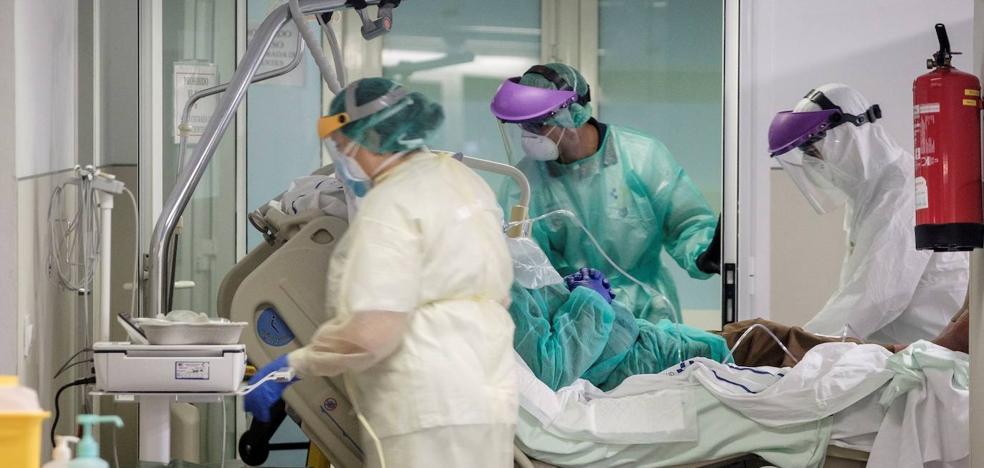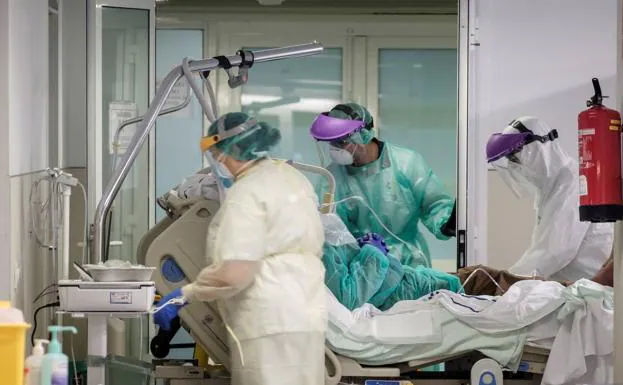[ad_1]
Health workers attend to a patient in the infectious diseases department. /
The patient, a middle-aged man with a tick bite, was taken to Hondarribia Airport on an Air Force medical plane from León this morning.
Donostia University Hospital welcomes the patient with Crimean-Congo hemorrhagic fever from León. The patient, a middle-aged man with a tick bite, was transferred this Thursday on a medical plane from the Ponferrada Regional Hospital, which lacks a high biological safety unit to prevent the spread of this disease.
The protocols for the transfer were put in place yesterday when the epidemiology department of the Junta de Castilla y León’s Territorial Health Service confirmed the case. The Ministry of Health then made an emergency call to various units, after which Osakidetza showed his willingness to admit this person to the Gipuzkoan center, one of the few in the state that has a high-level isolation unit necessary to treat these types of diseases.
The patient was transferred from León to San Sebastián this Thursday morning in an Air Force aircraft, a C-295 of Wing 35, by the Air Evacuation Medical Unit (UMAER) in direct coordination between the Ministries of Health of the two Autonomous Communities and compliance with the rules between the Cooperation mechanisms established by the Ministries of Health and Defense.
In a statement, the department headed by Gotzone Sagardui has reported that Osakidetza “has prepared all the protocols” to take care of the infected person “to ensure their isolation and safety”, as well as that of the team of professionals taking care of they will care.
Crimean-Congo hemorrhagic fever is caused by a virus whose main transmission mechanism is the bite of the tick of the genus Hyalomma, although it can also be transmitted from person to person through contact with the patient’s blood or fluids, which can occur especially medical personnel if they are not adequately protected.
In Spain, the virus was first detected in ticks in Cáceres in 2010. The first human cases were diagnosed in 2016 (1 case due to a sting in Ávila and another secondary case due to contagion in the health environment from the beginning); In 2018 there were another 2 cases (1 in Badajoz and one in Salamanca), in 2020 3 cases were reported from Salamanca and in 2021 another 2 cases (Salamanca and León). In addition, another case was identified retrospectively, corresponding to 2013, which would represent the first human case reported to date.

There is no specific treatment, although early diagnosis and supportive therapy improve survival. There is no approved vaccine in Spain either. Prevention includes measures to reduce the tick population and its hosts and to avoid tick bites. In addition, the professional and early elimination or removal of ticks in the event of a bite is recommended.
A high percentage (up to 90%) of human infection is asymptomatic. Among the symptomatic cases, most show mild symptoms: fever, myalgia, headache and dizziness (4-5 days). In a few cases, the disease develops into a severe clinical picture with hemorrhagic manifestations on the skin and mucous membranes (2-3 days), which can usually progress to death in the second week. The mortality rate ranges from 3% to 40% and increases with age (over 60 years) and other prognostic markers.
.
[ad_2]
Source link


